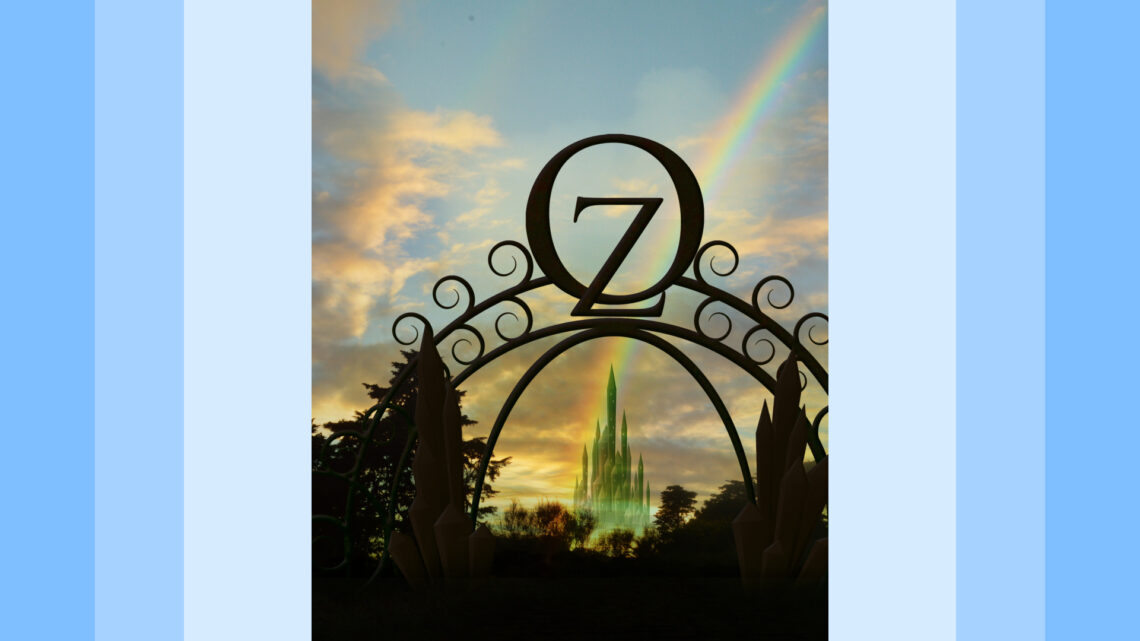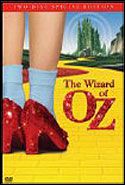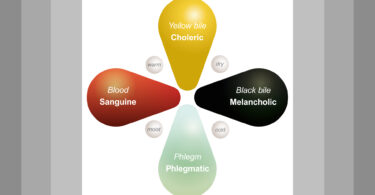The synopsis is an excerpt from http://www.imdb.com/title/tt0032138/synopsis Internet Movie Database. Some movie quotes were obtained from watching the movie. The more extensive quotes are from http://www.imdb.com/title/tt0032138/quotes.
Synopsis
Dorothy Gale (Judy Garland) is a teenager on a Kansas farm who daydreams about going “over the rainbow.” Along with her house and her dog Toto, she’s swept by a tornado from her black-and-white world to the magical, beautiful, dangerous and technicolor land of Oz. Dorothy’s house lands on, and kills, the wicked witch who rules the Land of the Munchkins, little people who think at first that Dorothy herself must be a witch. The Wicked Witch of the West (Margaret Hamilton), sister of the dead witch, threatens Dorothy. But Glinda (Billie Burke), the Good Witch of the North, gives Dorothy the dead witch’s enchanted Ruby Slippers, and the slippers protect her. Glinda advises that if Dorothy wants to go home to Kansas, she should seek the aid of the Wizard of Oz, who lives in the Emerald City. To get there, Dorothy sets off down the Yellow Brick Road.
Before she’s followed the road very far, Dorothy meets a talking scarecrow whose dearest wish is to have a brain. Hoping that the wizard can help him, the Scarecrow (Ray Bolger) joins Dorothy on her journey. They come upon the Tin Woodman (Jack Haley), who longs for a heart; he too joins Dorothy. As they walk through a dense forest, they encounter the Cowardly Lion (Bert Lahr), who wishes for courage and joins the quest in the hope that the wizard will give him some.
On the way to the Emerald City, Dorothy and her friends are hindered and threatened by the Wicked Witch of the West. Within sight of the city, the witch conjures up a field of poppies that cause Dorothy, Toto, and the lion to fall asleep. Glinda saves them by making it snow, which counteracts the effects of the poppies.
The four travelers marvel at the wonders they find in the Emerald City, but are frustrated at their reception by the “great and powerful” Wizard of Oz (Frank Morgan) — at first he won’t receive them at all. When they finally see him, he declines to help them until they bring him the broomstick of the Wicked Witch of the West. Daunted but determined, they set off again.
The witch sends winged monkeys to attack Dorothy’s party before they reach her castle; the monkeys snatch Dorothy and Toto and scatter the others. When the witch finds that the Ruby Slippers can’t be taken against Dorothy’s will as long as the girl is alive, she turns her hourglass and threatens that Dorothy will die when it runs out. Meanwhile, Toto has escaped and runs for help. Dressed as guardsmen, the Lion, the Tin Man, and the Scarecrow sneak into the castle and free Dorothy. They’re discovered before they can escape, however, and the witch and her guards corner them and set the Scarecrow on fire. Dorothy douses him with a pail of water, splashing the witch by accident. The water causes the witch to melt away. The guards are happy to let Dorothy have the witch’s broomstick, and Dorothy and her friends return to the Emerald City.
The wizard isn’t pleased to see them again. He blusters until Toto pulls aside a curtain in the corner of the audience chamber to reveal an old man pulling levers and speaking into a microphone — the so-called wizard, as the Scarecrow says, is a humbug. He’s abashed and apologetic, but quickly finds ways to help Dorothy’s friends: a diploma for the Scarecrow, a medal of valor for the Lion, and a testimonial heart-shaped watch for the Tin Man. Then he reveals that he’s from Kansas himself and came to Oz in a hot-air balloon, in which he proposes to take Dorothy home.
The wizard appoints the Scarecrow, Tin Man, and Lion rulers of Oz in his absence. Just as the balloon is about to take off, Toto runs away and, unable to stop, the wizard leaves without Dorothy. But Glinda appears and explains that Dorothy has always had the power to get home; Glinda didn’t tell her before because Dorothy wouldn’t have believed it. Bidding her friends a tearful good-bye, Dorothy taps her heels together three times, repeats “There’s no place like home,” and the Ruby slippers take her and Toto back to Kansas.
Dorothy wakes up in her own bed with Auntie Em (Clara Blandick) and Uncle Henry (Charley Grapewin) fussing over her. Professor Marvel, an itinerant magician (also played by Frank Morgan), and the farmhands Hunk (Ray Bolger again), Hickory (Jack Haley again), and Zeke (Bert Lahr again) stop by to see how she’s doing. She raises indulgent laughter when she tells them about Oz, but she’s so happy to be home she doesn’t mind that they don’t believe her.
Comments on the movie: To get a sense of the movie, watch some movie clips here: http://www.imdb.com/title/tt0032138/trailers
It is hard to believe this movie is 71 years old. It is surprising that a movie could remain so popular in our fast paced, rapidly changing times. The themes of courage, friendship, family, and good vs. evil have a timeless appeal.
I watched this movie several times as a child, but never as an adult. I found that the movie is full on humorous one-liners that a child would probably not catch. Here’s an example:
Scarecrow: I haven’t got a brain… only straw
Dorothy: How can you talk if you haven’t got a brain?
Scarecrow: I don’t know… But some people without brains do an awful lot of talking… don’t they?
Dorothy: Yes, I guess you’re right.
Even the name, Dorothy Gale, is a play on words because a gale is a huge storm with lots of wind.
Homeopathic Analysis: The Wizard of Oz movie is about a dream state, specifically a state that is similar to a remedy of the papavaraceae (poppy) family. The most famous homeopathic remedy of this family is Opium, and that is the remedy that could be attributed to this movie and to Dorothy. Other remedies of this plant family are Morphine, Codeine, Chelidonium, and Sanguinaria.
Dorothy’s dream consists of a place “Somewhere over the Rainbow” that is “far, far away.” This place has wonderful and vibrant colors as compared to the plain, drab state of Kansas. Dorothy enters this state as a result of fright, shock, and extreme danger from being caught alone in a tornado. She received a head injury and experienced a near death, coma-like state during which she visited the land of Oz.
MIND – DELUSIONS – visions, has – beautiful
MIND – AILMENTS FROM – fright
MIND – AILMENTS FROM – mental shock; from
MIND – DELUSIONS – body – out of the body
HEAD – INJURIES of the head; after
MIND – DELUSIONS – visions, has – coma vigil; in
While she was in the land of Oz, Dorothy had to flee from danger and the wicked witch. MIND – ESCAPE, attempts to
There was a fear of wild animals. “Lions and tigers and bears! Oh my!” MIND – DELUSIONS – animals
She also had a constant desire to go home.
MIND – DELUSIONS – home – away from home; he is – must get there
And of course, there was the overpowering sleepiness that Dorothy and her friends experienced when they walked through the poppy field that was placed in their path by the wicked witch’s spell. As a foreshadowing of things to come, I believe I saw poppies in the movie on Dorothy’s bedspread and bedroom wallpaper. SLEEP – SLEEPINESS – overpowering
The Wicked Witch of the West could be a representative of Sulphur. The Good Witch of the North even makes a reference to the bad smell of sulphur after the wicked witch left in her typical cloud of red smoke and fire. “Ooh! What a smell of sulphur!” The Wicked Witch is tall, dirty, lean and stoop-shouldered and wears rags as clothes. She is averse to water, and has monomania about those red slippers.
GENERALS – LEAN people
GENERALS – STOOP shouldered
MIND – DELUSIONS – rags are as fine as silk; old
MIND – DIRTY
MIND – MONOMANIA
GENERALS – WATER – aversion to
The lion seems to be a part of the Opium state. He has cowardice, fear with heart palpitations (as Zeke, the lion’s human counterpart) and in the end, he finds courage.
CHEST – PALPITATION of heart – fright; after
MIND – COWARDICE
MIND – COURAGEOUS
The scarecrow (and the human character Hickory) wants a brain, wants to be an intellectual, and becomes so when he receives a “Th.D,” a “Doctor of Thinkology,” from the wizard. He thinks he will have a statue erected in his honor. He could also be Sulphur, the tall, lean, philosophical, mechanically inclined, egotistical type of Sulphur.
Auntie Em: I saw you tinkering with that contraption, Hickory. Now you and Hunk get back to that wagon.
Hickory: All right, Mrs. Gale. But someday, they’re going to erect a statue to me in this town, and…
Auntie Em: Don’t start posing for it now.
Auntie Em could be the remedy Kali carbonicum. She is conservative, stout, irritable, work and duty oriented and follows all rules. She forced Dorothy to give Toto to Miss Gulch because “we can’t go against the law.”
Pulsatilla could fit the Tin Man who wants a heart. He is mild, gentle, sympathetic, and weeps often.
This analysis was prepared using the following sources:
Morrison, Roger, Desktop Guide to Keynotes and Confirmatory Symptoms
Sankaran, Rajan, Soul of Remedies
Radar’s Synthesis Repertory and Encyclopedia Homeopathica









Absolutely a welcome step for the hpathy.com articles. I liked it.
Several years back, I used to myself do it as a hobby for Hindi TV Serial Characters from Indian TV. [Well, the TV serials are usually arranged as 30 minutes episodes mostly daily telecast].
Suggestion: I find that we can attempt to establish some correlation with the TV Serial/ movie character photos and do facial analysis using the software. [Grant Bentley ]
See the web link
https://hpathy.com/homeopathy-papers/nine-steps-to-practising-homeopathy-using-facial-analysis/
Coincidentally, some people also do similar experiment using Astrology as well.
I congratulate author Julie Haza for this Novel approach. It is helpful in nurturing different kind of perspective for studying homeopathy.
Thanks
AB Patki
India
Dear Julie,
You are a true genius! Where have you been all our lives? What a revelational article! I absolutely agree that Aunt Em is Kali Carb! But wait, Julie, did you say what remedy Dorothy was? What about the Wizard and his counterpart the fortune-teller? I never would have thought of the wicked witch as Sulphur; but, you make a good point–she was killed by water! Great article, thanks!
Hi Elaine.
Thanks for your questions. Dorothy, as well as the overall movie, represents the opium state. You are correct; I didn’t think to comment on the Wizard and his Kansas counterpart, the Fortune Teller.
The rubrics that come to mind are:
MIND – Charlatan (a small rubric with only 5 remedies)
MIND – Untruthful(Opium is in BOLD)
MIND – Deceitful (Opium is in italics)
MIND – Liar (Opium is in BOLD)
Interestingly, morphinum, also of the papavaraceae family, comes up very strongly in those last 3 rubrics. Elaine, do you have any other ideas? Would anyone else like to share some suggestions?
Oh Julie, what a fun article. You not only gave insightful remedies for the main characters, but you wrote a brilliant synopsis of the movie itself. A great article from beginning to end. Keep them coming!
Dear Karen,
Thank you for your nice comments. I had a lot of fun writing this article. It is truly amazing to me how homeopathy can be seen anywhere. Even childrens’ movies!
I can’t take credit for the synopsis though. I did some online research while writing this, and found this synopsis and also movie clips at The Internet Movie Database (as cited in the article.) I thought this would be helpful for those who hadn’t seen the movie, or watched it a very long time ago.
Very much enjoyed reading your article 🙂
Absolutely enjoyable article. Perhaps Julie Haza, you may have started in motion a system whereby students may be taught specific traits of a remedy through movies. Everyone likes movies!
Thanks for a wonderful article.
Great and fun article! Maybe we should set up a database with characters from the world’s great literature and “homeopathize” them. It would be a lot of fun and a great way to learn about homeopathy. 🙂
Great article! I would, however, like to point out that Hickory was the Tin Man. Hunk was the Scarecrow.